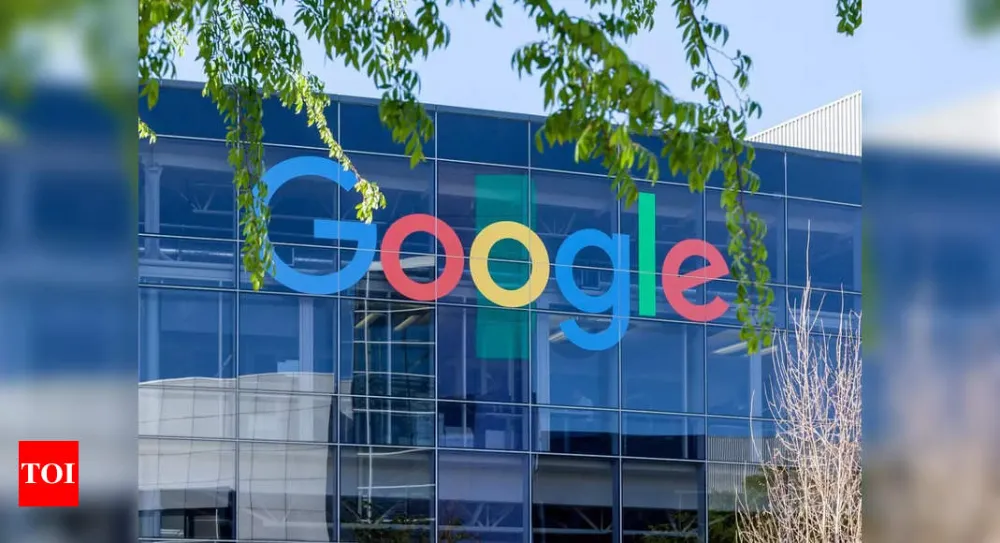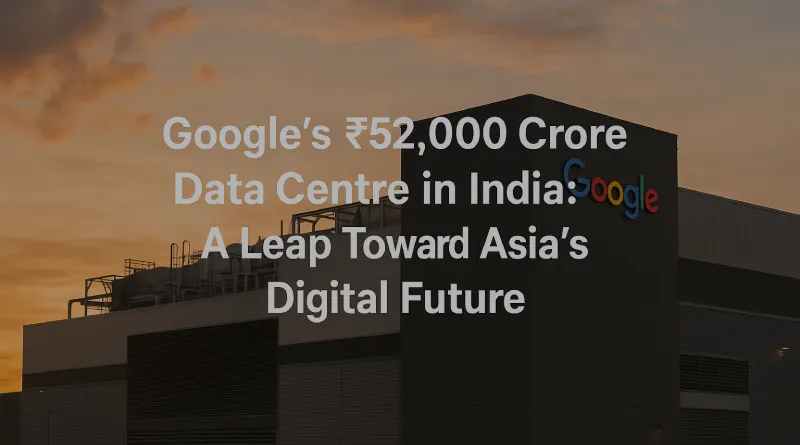Google’s ₹52,000 Crore Data Centre in India: A Leap Toward Asia’s Digital Future
Introduction
A revolutionary step in the Indian digital business, with its parent company Alphabet Inc., Google will invest a whopping sum of USD 6 billion (approximately 52,000 crores) in creating a 1-gigawatt (GW) data center located in Visakhapatnam, Andhra Pradesh. This and other equally reputable sources confirm that this is an ambitious project, the first of its kind in India, and will ultimately become the biggest data center in Asia in terms of capacity and size of investment. The program is in line with global sustainability missions, as it is using two billion dollars to develop the renewable energy infrastructure and highlights India as an emerging player in the cloud computing and AI environments. The findings are about the relevance of the project, its peculiarities, and the way it influenced the digital economy of India, paying much attention to the local context and reliable statistics.
The Scale of Google’s Investment
The Visakhapatnam data center, part of Alphabet’s $75 billion global data center expansion plan for 2025, will be a hyperscale facility capable of supporting tens of thousands of servers for cloud computing and AI applications. The 1-GW capacity translates to a potential storage range of 100 million to 1 billion gigabytes, sufficient to handle data for hundreds of millions of users. Of the $6 billion investment, $2 billion (₹17,000 crore) will fund renewable energy infrastructure to power the facility, reflecting Google’s commitment to sustainable operations. The project is part of a broader regional strategy, with Google also expanding data centers in Singapore, Malaysia, and Thailand.
Andhra Pradesh’s IT Minister, Nara Lokesh, highlighted the state’s ambition to become India’s data hub, with 1.6 GW of data center capacity already secured and a goal of 6 GW within five years. This surpasses India’s current operational capacity of 1.4 GW, as reported by real estate consultancy Anarock. Additionally, the state is developing three undersea cable landing stations in Visakhapatnam to enhance global connectivity, aiming to double Mumbai’s current bandwidth capacity. These efforts position Visakhapatnam as a strategic digital gateway in Asia.
Unique Insights: A Game-Changer for India’s Digital Economy
Google has made an investment that is indicative of a paradigm of digitalization of India, and this opportunity is given to AI and cloud computing, which are now in demand around the world. The facility at Visakhapatnam is a hyperscale data center, unlike existing Google cloud regions in India, in Mumbai and Delhi, as the former is optimized to run large volumes of compute tasks that generative AI will be generating, and the hyperscale data center will be located at Visakhapatnam. It implements this localization to increase data sovereignty and cut latency to benefit Indian users, which is essential to businesses and startups that utilize the solutions that leverage AI.
Also noted in the project is how Andhra Pradesh has become a technology investment destination ever since it was bifurcated in 2014 from Hyderabad, which moved to Telangana. With its pledge from Google and other companies such as Sify Technologies (investing in a 550 MW data center to the tune of $1.9 billion), Andhra Pradesh is trying to overcome its financial problem as well as betting on the global race towards building the digital infrastructure. The target to use renewable energy meshes with the 2070 net zero target set by India and provides an example of sustainable tech innovation that might win more investments by companies such as Microsoft and Amazon, which have committed to investing in Indian data centers at the cost of 3.7 billion USD and 13 billion USD, respectively.

Local Context: Transforming Andhra Pradesh and India
In the case of Andhra Pradesh, Google investment is an economic windfall, with the post dubbing it as Rockefeller’s finances over 6,000 direct and indirect jobs. The venture is also located in a 500-acre Data City in Visakhapatnam in the Madhurawada area, with Google occupying about 80 acres. The move is in line with the desire of the state to reconstitute its economy due to the loss of Hyderabad, which serves as a mega technological center. The proposed undersea cable stations will boost the connectivity of Visakhapatnam, which will soon become the competitor of Mumbai as a digital gateway to India.
In the bigger Indian picture, the data center enhances the role of India in the global tech environment. As India has an internet population of more than 600 million and an emergent startup ecosystem, India is a goldmine to invest in data infrastructure. The Visakhapatnam institute will help India move to its digital future, enabling everything that runs the gamut from e-commerce to AI-powered medical therapies. Project execution may, however, be affected by their high requirements on energy (projected to be 10 GW over five years) and the regulatory dimensions, such as the recently introduced tariffs in the US by President Trump. The intention by Andhra Pradesh to introduce backup power by use of coal to supplement renewable energy to bring in reliability denotes a practical perspective of these challenges.
Competitive Landscape and Industry Trends
Google is not the only company doing this, and other global tech forces such as Microsoft, Amazon, and OpenAI, along with Indian companies like Reliance Group, are also quietly pumping a lot of funds into Indian data centers. An example of this can be seen with Reliance constructing a 3-GW data center in Jamnagar, Gujarat, and Blackstone looking to construct an investment valued at 6 billion dollars in Maharashtra. These projects portray the strategic interest of India as an outpost of data because it has a low cost of operations and favorable regulations such as the IT Rules, 2021. Private developments in the digital infrastructure are further highlighted with the emergence of edge computing and the growth of co-location facilities in tier-2 cities in India; data center occupancy rates in 2023 have the potential to rise to 75-80%.
Challenges and Future Outlook
In spite of the Visakhapatnam project being an important step, certain issues such as the scalability of energy infrastructure and possible regulatory pressure under the Indian data localization regulations are associated with the project. The heavy dependence on power—coal-based power—may not augur well with environmental agencies. Nevertheless, the reason for supporting Google in green energy and connecting Andhra Pradesh negates such issues to a great extent. More timeline and partnership details will probably be provided upon the official announcement of the project in October 2025, which will include such plans as the MoU with the Andhra Pradesh government to develop AI and skills in December 2024.
Conclusion
The 52000 crore data center in Visakha Patnam being built by Google is a game changer in the future of Indian digitization and is only one more reason why Andhra Pradesh stands as a powerhouse in the tech industry. Integrating and connecting with sustainable energy and giving added connectivity with hyperscale infrastructure makes this project reinforce India in artificial intelligence and cloud computing. This investment of Google has established a precedent in terms of innovation and collaboration as India successfully moves forward to write its own narrative as the nation surmounts the challenges of economy and regulation and as the region promises economic growth and technological advancement.
Disclaimer
The information presented in this blog is derived from publicly available sources for general use, including any cited references. While we strive to mention credible sources whenever possible, Web Techneeq – Best Digital Marketing Company in Mumbai does not guarantee the accuracy of the information provided in any way. This article is intended solely for general informational purposes. It should be understood that it does not constitute legal advice and does not aim to serve as such. If any individual(s) make decisions based on the information in this article without verifying the facts, we explicitly reject any liability that may arise as a result. We recommend that readers seek separate guidance regarding any specific information provided here.

